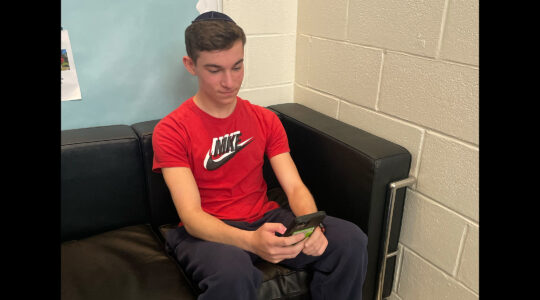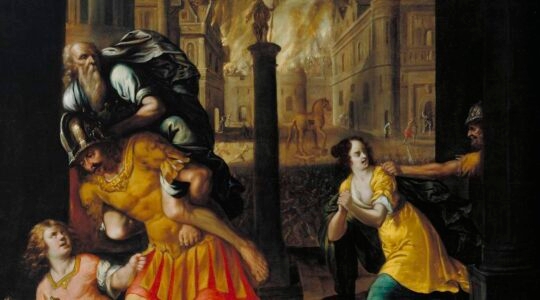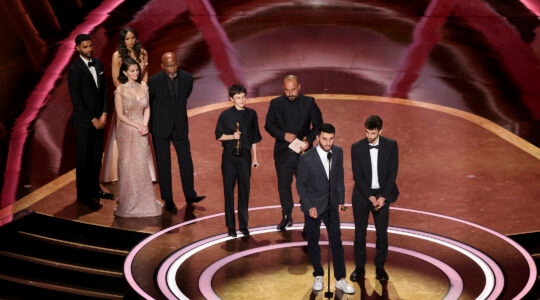NEW YORK (JTA) — Near the start of the dance performance piece “Brothers,” break dancer and choreographer Ephrat Asherie turns and faces the audience dressed like a boy. Her long brown hair is covered by a black bandana and she wears a plain red sleeveless sweatshirt. Her baggy jeans are ripped open, thigh down to shin, which exposes her black kneepads, a basic piece of equipment for any b-girl.
Completing the gender-bending look are her arms, which are so chiseled they would make Madonna envious.
The soundtrack, which until this point had been a series of fast percussive beats, falls away and the voices of two of Asherie’s older brothers, Gil and Neer, fill the small space at Dixon Place, an experimental theater venue in downtown Manhattan. They, along with two other elder Asherie boys, are the titular “brothers” of the piece, and in their narration they recount the myriad ways they picked on her. Despite the harassment growing up, Ephrat, the youngest and only girl, wanted to be just like them.
“They were the coolest people I knew,” the Israeli-born Asherie, 30, explains of the four older siblings she chased throughout her childhood in suburban New York’s Westchester County.
“They could run faster than me, they could ride their bikes faster, they could pee standing up,” she says, laughing.
Eventually she went from chasing her brothers and playing soccer to ballet — at the behest of her mother, who wanted to see her do something a bit more feminine. But after years of studying ballet and modern dance, Asherie returned to her rough-and-tumble roots when she discovered break dancing while a student at Barnard College, a women’s school affiliated with Columbia University, where she studied Italian.
In less than a decade since graduating, Asherie has taught break dancing all over the world, including in Europe, Israel and South America. She also has appeared in music videos, and on music award shows and television programs, notably "Saturday Night Live."
In breaking, as it is often called by its practitioners, b-boys and b-girls, Asherie found a respite from leotard, tights and mirrors that only seemed to highlight her figure flaws.
“I didn’t have to look like anybody else or be super skinny,” she says of the difference between ballet and street dance, which is typically performed in baggy attire, hats and sneakers. “I loved the music and the freedom I first saw in it. The freedom to not have to be self-critical. I could just enjoy the music.”
As for her attraction to genres such as breaking and hip hop, which the Harlem resident teaches at dance studios throughout New York, including at the prestigious Broadway Dance Center, she explains, “For me all of the dances that are rooted in an African tradition are so much more soulful than anything I’ve ever encountered in my life.”
But none of this mattered during her first encounters with breaking. While she acknowledges the unsophisticated sound, Asherie confesses, “I was drawn to it because it was dope. It was just freakin’ awesome.
"Why wouldn’t everybody want to do that?” she asks as though it is a rhetorical question. “It didn’t even occur to me not to fall in love.”
Asherie feels the same ardor for the b-girl’s favorite apparatus. “I just really love the floor,” she says.
Most of the iconic breaking moves — headspins, windmills and backspins — are done on or near the ground. As a result these elements, even at their most extreme, connote a sense of play, like kids palling around. After all, this is how the dance form evolved — young adolescents in New York City fooling around on the concrete until they stumbled on a new dope skill, which they honed.
The same sense of play pervaded the entire Dixon Place showcase. In keeping with the childhood centric trope of “Brothers,” Asherie assigned the theme “looking back” to the rest of the dancers. In addition to performing a solo piece, she participated in two group routines with her house dance group, Mawu, an all-female crew. The opening piece, titled “Playground,” had the four women dressed in young girls’ school uniforms enacting a schoolyard scene with house dance elements.
But this is not the "Jersey Shore"-style of house dance, which entails techno, fist pumps and vigorous pointing at the beat. Underground house dance arose from the Chicago disco scene in the 1970s and incorporates several styles, including salsa and African, but with a smoothness and attention to the groove. Often the nimble and intricate footwork makes it seem like the dancer is tap dancing without taps.
One particularly original moment in the set had the ladies of Mawu miming a game of double dutch jump rope to a funk-techno beat.
Adding to the “years gone by,” at least for Asherie, was the performance of Claudia Aarts-Schrieber; she and Asherie studied ballet together as youngsters in Westchester. Aarts-Schrieber stayed with ballet, eventually joining the Norwegian National Ballet in Oslo. Aarts-Schrieber’s presence on the stage provided a stark example of “the road not taken.”
Not that Asherie regrets veering away from the more traditional modes, even as she faces the uphill battle, like all underground dancers, of trying to turn her passion into a paycheck.
“There’s no hip-hop company that will pay you the way" a modern dance company, such as Alvin Ailey, "pays their dancers,” she observes.
“With underground dancers, a lot of the pioneers end up teaching overseas and doing most of their work overseas, which is a really sad thing because there is not enough work for them here,” Asherie says. “So what is the next generation supposed to do? That’s where a lot of us in my generation have got to create our own thing, find your own way.”
That’s where nights such as the one Asherie curated at Dixon Place come in. When Asherie reached out to the dance community about performing, she expected just a few to respond but was pleasantly surprised by the enthusiastic response. In addition to herself and Mawu, five other individual performers and groups agreed to participate.
“I don’t think there are so many opportunities in the theater setting,” she explains.
Though the dancers were willing to perform sans pay, Asherie raised $2,000 to compensate them.
“I wanted to show that I’m a dancer and choreographer, and I’m fighting for all of us to have a better life," she said. "We shouldn’t have to do shows for free.”
Such concerns reflect a hard reality about breaking — even if you book the big commercial gig, it still doesn’t secure the future. “What’s the next step?” Asherie wonders.
For her part, Asherie plans to take the money she makes from her more commercial work to finance the theatrical pieces — more repertory shows of shorter pieces and then, hopefully, an evening length piece at a bigger venue.
“I want underground styles to be appreciated and respected in many different contexts. In the contexts they were created — the street, the club, battles. But also on stage,” she says.
And it’s onstage, after the music stops and her brothers finish narrating their tales of childhood torture — and after she finishes dancing, jumping and backspinning her way across the floor — that Asherie again faces the audience, tugs off the bandana and lets her long hair loose. She may no longer be a ballerina or the tomboy who chased after her brothers at her own peril. But onstage, she brought those personas together to become a voice for the underground.
JTA has documented Jewish history in real-time for over a century. Keep our journalism strong by joining us in supporting independent, award-winning reporting.





